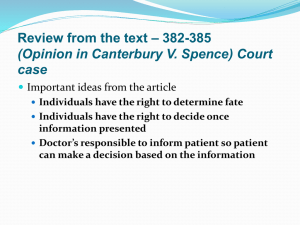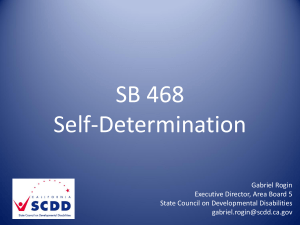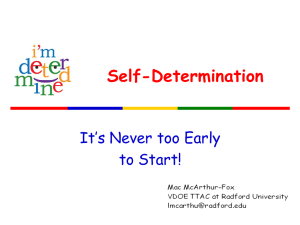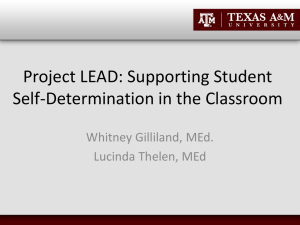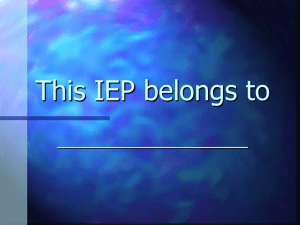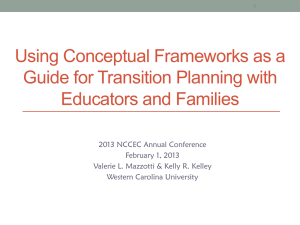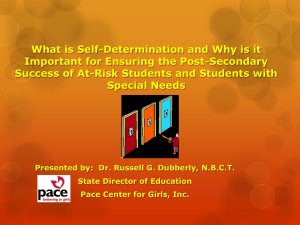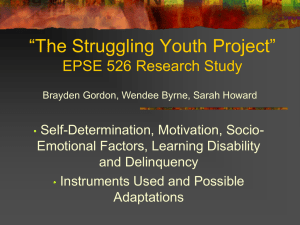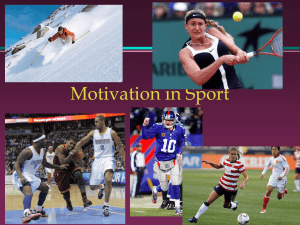Person Centered Planning Presentation
advertisement
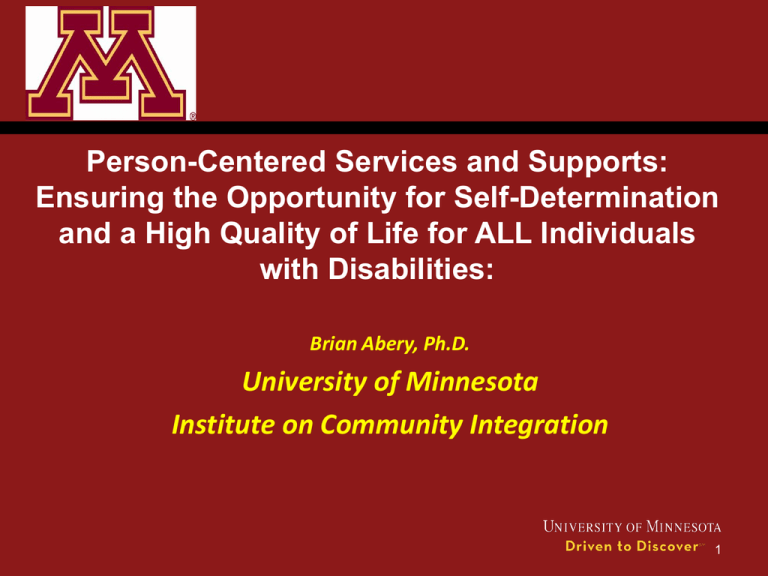
Person-Centered Services and Supports: Ensuring the Opportunity for Self-Determination and a High Quality of Life for ALL Individuals with Disabilities: Brian Abery, Ph.D. University of Minnesota Institute on Community Integration 1 What is the Connection Person-Centered Supports Quality of life Self-Determination Functions of the Quality of Life Construct? • Sensitizing notion: gives society a sense of reference and guidance from the individual’s perspective, focusing on the person and the individual’s environment; • Social construct used as an overriding principle to enhance an individual’s well-being and facilitate collaboration for change at the societal level; and • Unifying theme that provides us with a common language and a systematic framework to apply quality of life concepts and principles. Core Q of L Domains • Desired states of: – Emotional well-being – Interpersonal relations, – Material well-being, – Personal development, – Physical well-being, – Social inclusion, – Self-determination and rights. Differences in Q of L • Q of L differs for the individual – Over time and – Between individuals. • A good “quality of life’’ may mean different things to different people. Q of L & Self-Determination • Q of L relates to: – Decisions/choices by individuals and, wherever possible, – Personal control over their: • Activities • Programs & Interventions, and • Environments. • Acceptance of the right to self-determination on the part of consumers has major implications for self-image, motivation, selfexpression and control, as well as health. What is Q of L Not About? • Keeping people safe at all costs Without the chance to take a risk there is little dignity to life. Irving Martin, self-advocate What is Self-Determination? • The basic rights of all human beings include their freedom, equality, and power to execute their will… • These rights are distinguishable from people themselves and can be given up to others, but only under conditions in which the individual gives their consent… • Situations in which basic rights are never granted or when a person is subjected to the arbitrary and/or absolute will of another are a form of slavery Locke, John (1690) Two Treatises of Government What is Self-Determination? • The attitudes, abilities, and knowledge to set goals for oneself and effectively work toward the achievement of those goals. Michael Ward, Ph.D. • Self-determination is believing in yourself, making your own decisions, and being responsible for them High School Student, North Dakota • Power, choice, and most important, the right to chase our dreams...The chance to direct our lives the way we want to, not the way others expect us to... Irving Martin, Self-Advocate, Minnesota 9 Operational Definitions • Self-determination refers to individuals exercising the degree of control over their lives that they desire within those areas of life that are important to them. Abery & Stancliffe (2003) What is Self-Determination NOT? • Self-Determination is not: – Equivalent to one’s level of personal control – An “either/or” experience – Parent’s, family members, or other substitute decision-makers exercising control over the life of a person with a disability Common Misconceptions about Self-Determination • Self-determination implies the independent performance of behaviors (either/or argument) • Self-determination is primarily about making choices • There are a specific set of skills, knowledge, and attitudes/beliefs NECESSARY for selfdetermination • Self-determination is a program you can implement – e.g., person-centered support planning, independent budgets Self-Determination & Personal Control How are they are different? • Shared Control – Most individuals do not desire to have complete control but wish to share it in some areas with trusted others. • Ceding Control to Others – In some areas of life a person may not particularly value having control and voluntarily cede it to others. – In other areas they may voluntarily cede control because they do not have the skills to make informed decisions • Individual Differences/Change Across Time – Areas of life over which personal control is valued are different for each person and typically change over time. What is Self-Determination? • Control over day-to-day decisions – what to wear – what to eat – what time to go to bed • Control over long-term decisions – where and with whom to live – where to work – What type of work to do What is Self-Determination? • Self-determination is about supporting people to make the things that they want to happen…actually happen in their lives. Tripartite Model of Self-Determination Self-Determination Desired Degree of Control Importance Exercise of Control Changes over TIME Self-Determination: An Ecological Process Macrosystem SELF-DETERMINATION Exosystem Mesosystem Mesosystem Person Self-Determination Competencies •Skills • Attitudes/Beliefs • Knowledge Residental Serv. Microsystem Mesosystem Microsystem School/Work Microsystem Exosystem Changes over Time Exosystem Microsystem Importance Peer Group Mesosystem Exosystem Family Exercise of Control Desired Degree of Control Missing Factor: The Environment • Most agree that many (though not all) people with disabilities living in the community do not experience a high quality of life. • Reasons are multifaceted: − Some residential environments support selfdetermination and a high Q of L. − Many do not as they are full of barriers to an individual living the type of life that they desire. − Rules and regulations, often design to “protect” persons with disabilities often serve as barriers to a high Q of L and self-determination What We Know • To date, interventions designed to support a higher Q of L and greater self-determination for persons with disabilities have primarily been focused on teaching persons with disabilities skills…requiring/asking them to change. • Dangers related to this approach… – Some people may not be able to acquire the capacities being taught…does this mean they are not capable of self-determination and a higher Q of L? What We Know • Previous research suggests a number of ecological characteristics related to a high Q of L and self-determination including: – – – – – Organizational climate Agency policies & regulations, The knowledge, skills, and attitudes/beliefs of DSPs The behaviors of DSPs The personal capacities and behaviors of supervisory staff and organizational leadership 20 Mediating Factors • Social Capital: Network of social ties, supports, relationships, affiliations, and social-behavioral reciprocity that support one to achieve desired outcomes – Bonding: Affiliating with others who share common characteristics – Bridging: Affiliating with others who have different characteristics • Social Inclusion: Societal acceptance of persons with disabilities in school, work, and community contexts. – Degree of inclusion has an impact on Q of L and opportunities for self-determination Mediating Factors • Access to and effective implementation of person-centered services and supports – Most residential and employment support services are not person-centered or individualized but… • Institutionalized – ISP more, often than not, is an acronym for an institutionalized service/support plan rather than an individualized/person-centered plan Person Centered Supports Smull, Bourne, & Sanderson (2009) What has Gone Wrong? • Most efforts to support an enhanced Q of L and greater SD have focused almost exclusively on facilitating changes at level 1 – person centered practices Shift in Goals: A Need for Systems Change • GOAL: Create person centered systems that support person directed services. – Changes in rules and practice should be driven by learning what is and is not working for individuals. – Using a small set of value-based skills at all levels of the system will drive change throughout the system. – Using these skills in conjunction with selected quality management and organizational development tools will improve quality of life and increase organizational effectiveness and efficiency. 25 Need to Refocus our Efforts Training in person-centered planning Training in person centered thinking Training + Development & support of coaches Training coaches + sustained engagement of organizational leadership Training, coaches, organizational leadership + sustained engagement of system leadership Smull et al, (2009) Why Training Alone Fails to Work • Training, no matter how good, is the classic “rock in the pond” (Smull, 2006). – The rock, tossed in the pond makes waves. – The bigger the rock, the bigger the waves. – But no matter how big the rock, the pond eventually goes still again. 27 Why Training Alone Fails to Work • Most training approaches result in water quickly returning to an undisturbed state. • “Training in person-centered plan writing, by itself, results in better paper, not better lives.” Smull, Bourne & Sanderson 2009 28 Need for Systems Change – Goal is to have the person-centered thinking used in everyday work • At ALL levels of the organization & system – Only in this manner will person-centered plans person-centered services and supports serve as the basis of the day-to day, moment-to-moment interactions greater self-determination and a higher quality of life. Need for Systems Change • Strongest predictor of success is the degree to which leadership engages in the effort. – Management & Leadership needs to: • Embrace person centered thinking • Help determine what is and isn’t working and • Share responsibility for achieving the vision of delivering person-centered service on a day-today, moment-to-moment basis We’re All in this Together • All persons within the system from – DSPs – Supervisors – Upper level management – Board members – County and state managers/leaders need to learn what is working and not working both within a specific organization and the system as a whole as far as applying person centered thinking. – Senior management needs to hear what DSPs and supervisors have learned and then act on the learning. 31 We’re All in this Together • System/Organizational leaders will typically discover that: – Though there are many changes that they can make at an organization level… – Some of what is not working reflects the need for system change. – Changes are needed in the system rules, practices, and structures. We’re All in this Together • Currently all too much of what goes on in the delivery of supports to persons with IDD is about: – Protecting and minimizing liability rather than enhancing lives – EXAMPLE: Protection plans • Introduced to protect persons with IDD • Today more often serve to eliminate persons with disabilities experiencing ANY level of risk thereby protecting support organizations We’re All in this Together • Current state of affairs not just fault of support organizations, but rather… – A reaction to many of the current rules and regulations by which they are required to abide. – Many of which fall under what Smull & Associates would label as “stupid stuff.” 34 We’re All in this Together • Efforts to develop person-centered systems require system leaders and managers to actively engage in and apply the same personcentered thinking in their work that supervisors and DSPs are applying. We’re All in this Together • The degree of engagement from leadership is the strongest predictor of success – Not just leadership within provider organizations – County and State must be involved. From Individual to… Systems Change Smull, Bourne & Sanderson 2009 What Will it Take? • Capacity: – The discrete characteristics that enable a system/organization to change in the desired direction (Hatch, 2009) • Four components: – Human Capital – Social Capital – Program Coherence – Resources Human Capital • Those personal capacities possessed by members of the organization: – Knowledge – Skills – Commitment – Disposition – Other abilities Social Capital • Closely linked to human capital • Component of capacity inherent in the relationships between and among: – Members of an organization – Members of other organizations with whom they work Social Capital • Four elements: – – – – Mutual understanding Development of collective competence Fostering of care and concern Support for the alignment of mutual goals Gameron, Gunther & Williams, (2005) • Stimulated by: – Trust – Reciprocity – Open communication and flow of information Program Coherence • The degree to which staff (at all levels) and resources within an organization are coordinated and integrated via a common framework (Newmann, et a., 2001) – Organization embraces a common framework for the delivery of support services. – Working conditions support incorporation of personcentered thinking into everyday practice. – Sufficient time and resources are devoted by the organization to fully implement the person-centered thinking and practices. Resources • The physical and organizational tools that an organization has at its disposal to make its improvement goals a reality (Newmann, et al, 2001) – Adequate staffing levels – Staff stability – Professional development opportunities
